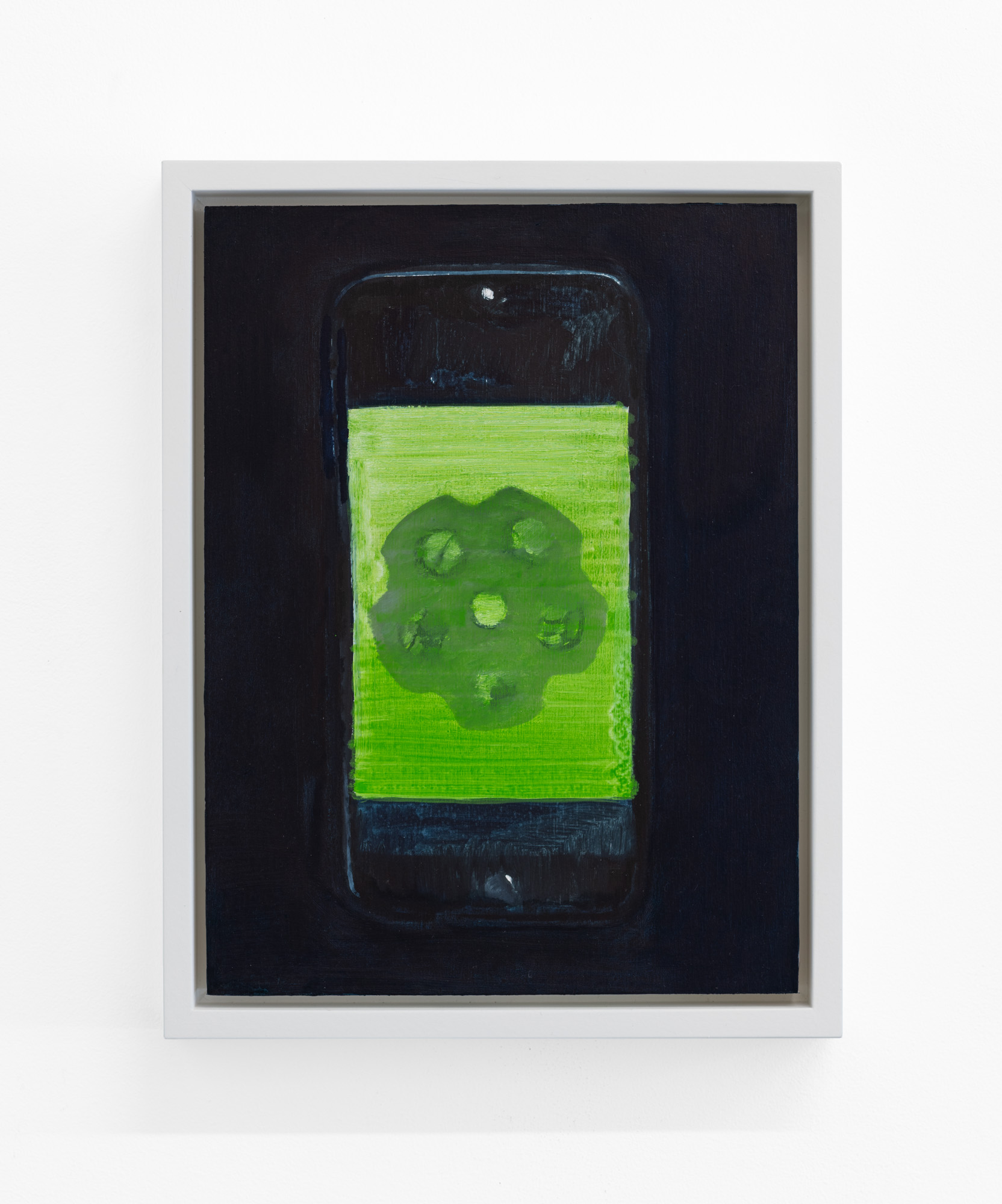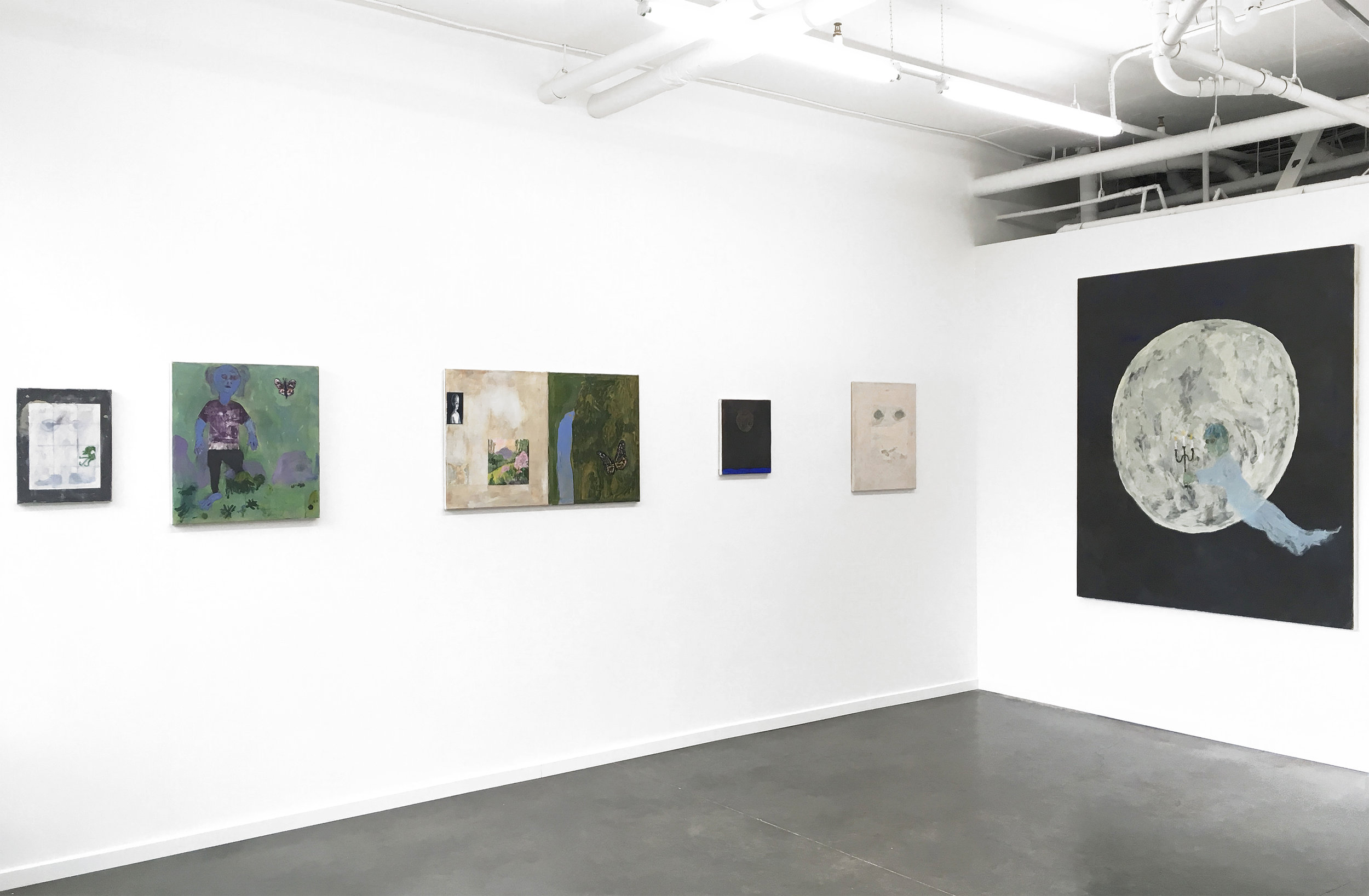The night is long and poor in council. — Samuel Beckett (Malone Dies)
An absorbing solitude runs through William Matheson’s Antigen exhibition, evoking the remoteness, the chill, silence, and revelry of deep night. There’s also a hint of subversion in the way each painting registers as mind-image: that noiseless moving picture ever playing behind the eyelids. And it’s the social content behind Matheson’s new body of work that causes this. Here, the personal and the public merge in ways that allow Matheson to readily connect through his medium. He does so with the innovative hand of an adept painter, the mind of an occultist, upping the ante of what painting can communicate.
Matheson’s content—addiction and Big Pharma; memory, loss, and the desire to preserve life in the face of societal and environmental collapse—is self-evident (as the doomy palette of the nocturne is wont to be) and yet discreet, never treacly. He successfully employs his medium to show instead of tell. In one painting, Phone (Fentanyl) (2019), a foil dispenser for the opioid Fentanyl mimics the petal-and-sepal formation of a flower. This is a reminder that direct observation can blend seamlessly with intellectual and emotional positions. The fact of death looms, making Antigen both attractive and repellent, not to mention Matheson’s turns of radar-green and what they invoke. Each person faces death in life while fearing it, unable to grasp it completely, while art is there to provide innocuous inklings. Just a little drop of poison casts light on the universal: curtains, darkness, the end.
Phone (Fentanyl), 2019, oil on panel, 12 x 9 inches
Paintings are so attractive, in part, because they’re often readily accessible, easy to take in as it’s all there on the flat canvas, pleasing to the eye and to the mind. “What you see is what you see” as the Frank Stella adage goes (or rather, went). Paintings are also in service to question surrounding social realities as related to one’s own. Matheson’s nocturnes draw the mind into recessed, shadowy spaces, encouraging (if not requiring) long-looking. Because of his painterly ingenuity, what you see you also don’t see. As I walked through Nationale to look at Matheson’s latest works, each painting literally changed before me. This is a trait that I look for in any art form, the dynamic ability to surprise as time passes; when a representational painting has this quality, it disorients in a good way.
In Night Computer (Preserved Shark) (2019), a green glow bears the image of, you guessed it, a shark, preserved in a jar as a scientific specimen. Despite the fact of the apparent formal frankness of the composition—a computer turned on in the dark—a hidden image sits waiting for the viewer’s changed perspective. Standing beside the painting to gaze across its surface edgewise, the grid formation of a keyboard magically appears, black-on-black, baffling the eye and the mind. The surface and depth of the painting vibrate in apparent flatness that made me question what paintings are.
Night Computer (Preserved Shark), 2019, oil on canvas, 26 x 40 inches
Having seen and walked away from the exhibition, I began to wonder what other hidden optical nuances were being transferred, subliminally dispatching things to which the eye might latently attend. In another painting (spoiler alert), Night Window with Ghosts (2019)—this one a still life of a reed in a bottle in front of a photograph taped to a wall—figure and ground (and thus perception) are destabilized by a “sudden” apparition, putting in a vapory appearance somehow behind the dark background of a wall. The dim pallor of a face below dark brushstrokes that communicate “hair” is enough to make the whole exhibition worthy of return visits, deeper consideration, maybe a nightmare or two. I thought to myself, if such optical tricks can be played in paint, why don’t artists play them more often? The answer is that to do so at all means to risk relating to the hoary tradition of parlor games.
Night Window with Ghosts, 2019, oil on canvas, 26 x 40 inches
With Antigen, however, Matheson successfully activates the visual field (i.e. it’s specifically not static) making the case for the medium of painting at a time when it seems anything is possible when it comes to image rendering and communication (I’m thinking VR, holograph, video, and everything else). Surface and depth fluctuate, hover and sink, and emphasize the fact of the unseen relative to the image. The exchanges, juxtapositions between the glow and pitch from within these paintings, make for an engaging, memorable experience. In the art historical tradition of the nocturne, Matheson is working within and commenting on the objective rendering that is in service of evoking subjective states, memories, fears, longings, emotions—in short, the unseen. To put this style into practice now, by way of subjects that refer to the often banal trappings of contemporary life (iPhones, laptops and the endless “content and information” they project), Matheson’s work satisfies; his occupation takes note of our period. It encourages change in how to see the world, calling for an engrossed consideration of the image, what we use to see and process it: the screen, the eye, the mind.
This commissioned essay is supported in part by a Project Grant from the Regional Arts & Culture Council.
Paul Maziar is a writer and editor. His art writings can be read at ArtPractical, ArtCritical, The Los Angeles Review of Books, Oregon ArtsWatch, WhiteHot Magazine, and Rrealism.
William Matheson lives and works in Portland, OR. He has exhibited nationally at galleries in Richmond, VA, Washington, DC, and New York. Internationally, his work has been shown in Switzerland, South Korea, Japan, and the Czech Republic. Matheson is the recipient of a Milton and Sally Avery Fellowship Award from the Vermont Studio Center in Johnson, VT, an Artist Grant from The Elizabeth Greenshields Foundation in Montreal, and a recent Project Grant from the Regional Arts and Culture Council in Portland, OR. He has been an artist-in-residence at the Örö Residency Programme in Finland, Mass MoCA in North Adams, MA, AIRY in Kofu, Japan, and the Vermont Studio Center. Matheson received his MFA from Virginia Commonwealth University in Richmond, VA, in 2016 and his BFA from Portland’s Pacific Northwest College of Art in 2013. He is represented by Nationale in Portland, OR.













